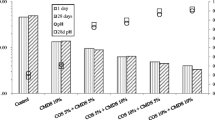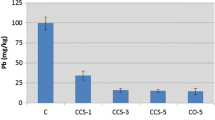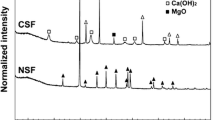Abstract
In this study, As-, Pb-, and Cu-contaminated soil was stabilized using calcined oyster shells (COS) and steel slag (SS). The As-contaminated soil was obtained from a timber mill site where chromate copper arsenate (CCA) was used as a preservative. On the other hand, Pb- and Cu-contaminated soil was obtained from a firing range. These two soils were thoroughly mixed to represent As-, Pb-, and Cu-contaminated soil. Calcined oyster shells were obtained by treating waste oyster shells at a high temperature using the calcination process. The effectiveness of stabilization was evaluated by 1-N HCl extraction for As and 0.1-N HCl extraction for Pb and Cu. The treatment results showed that As, Pb, and Cu leachability were significantly reduced upon the combination treatment of COS and SS. The sole treatment of SS (10 wt%) did not show effective stabilization. However, the combination treatment of COS and SS showed a significant reduction in As, Pb, and Cu leachability. The best stabilization results were obtained from the combination treatment of 15 wt% COS and 10 wt% SS. The SEM-EDX results suggested that the effective stabilization of As was most probably achieved by the formation of Ca-As and Fe-As precipitates. In the case of Pb and Cu, stabilization was most probably associated with the formation of pozzolanic reaction products such as CSHs and CAHs.




Similar content being viewed by others
References
Ahmad M, Hashimoto Y, Moon DH, Lee SS, Ok YS (2012) Immobilization of lead in a Korean military shooting range soil using eggshell waste: an integrated mechanistic approach. J Hazard Mater 209–210:392–401
Ball DF (1964) Loss-on-ignition as an estimate of organic matter and organic carbon in non-calcareous soil. J Soil Sci 15:84–92
Chirenje T, Ma LQ, Clark C, Reeves M (2003) Cu, Cr and As distribution in soils adjacent to pressure-treated decks, fences and poles. Environ Pollut 124:407–417
Choi J-S (2012) The status and utilization prospect of steel making slag. Architect Res 569(8):18–21
Chung IJ, Choi YS, Hong SW, Park HM (2001) Immobilization of arsenic in tailing by using iron and hydrogen peroxide. Environ Technol 22(7):831–835
Dermatas D, Menouno N, Dutko P, Dadachov M, Arienti P, Tsaneva V (2004) Lead and copper contamination in small arms firing ranges. Global Nest J 6:141–148
Drahota P, Filippi M (2009) Secondary arsenic minerals in the environment: a review. Environ Int 35:1243–1255
Dutré V, Vandecasteele C (1998) Immobilization mechanism of arsenic in waste solidified using cement and lime. Environ Sci Technol 32:2782–2787
Dutré V, Vandecasteele C (1996) An evaluation of the solidification/stabilization of industrial arsenic containing waste using extraction and semi-dynamic leach tests. Waste Manage 16(7):625–631
FitzPatrick EA (1983) Soils: Their formation, classification and distribution. Longman Science & Technical, London, p 353
Gezer ED, Yildiz ÜC, Temiz A, Yildiz S, Dizman E (2005) Cu, Cr and As distributionin soils adjacent to CCA-treated utility poles in eastern blacksea region of turkey. Build Environ 40:1684–1688
Johnson CA (2002) Metal binding in the cement matrix: an overview of our current knowledge. Department of Water Resources and Drinking Water, Water-Rock Interaction Group, EAWAG, for Cemsuisse, Switzerland
Kim JY, Davis AP, Kim KW (2003) Stabilization of available arsenic in highly contaminated mine tailings using iron. Environ Sci Technol 37:189–195
Koo J, Song B, Kim H (2008) Characteristics of the release of chromium, copper, and arsenic from CCA-treated wood exposed to the natural environment. Anal Sci Technol 21(1):1–8
Kumpiene J, Lagerkvist A, Maurice C (2008) Stabilization of As, Cr, Cu, Pb and Zn in soil using amendments—a review. Waste Manage 28:215–225
Lee KC (2006) Immobilization characteristics of arsenic contaminated soil using soluble phosphate and arsenic coagulant, Master thesis, Sangmyung University, Republic of Korea
Lee JY, Hong CO, Lee CH, Lee DK, Kim PJ (2005) Dynamics of heavy metals in soil amended with oyster shell meal. Korean J Environ Agr 24:358–363
Lee CH, Lee DK, MA A, Kim PJ (2008) Effects of oyster shell on soil chemical and biological properties and cabbage productivity as a liming materials. Waste Manage 28:2702–2708
Lee KY, Moon DH, Lee SH, Kim KW, Cheong KH, Park JH, Ok YS, Chang YY (2013) Simultaneous stabilization of arsenic, lead, and copper in contaminated soil using mixed waste resources. Environ Earth Sci 69:1813–1820
Li XD, Poon CS, Sun H, Lo IMC, Kirk DW (2001) Heavy metal speciation and leaching behaviors in cement based solidified/stabilized waste materials. J Hazard Mater A 82:215–230
MDI (2005) Jade Version 7.1. Material’s Data Inc., Livermore, California, USA
Milton F (1995) The preservation of wood. A self-study manual for wood treaters, college of natural resources, University of Minnesota, p. 102
MOE (2002) The Korean Standard Test (KST) Methods for Soils (in Korean), Korean Ministry of Environment, Gwachun, Kyunggi
Moon DH, Cheong KH, Khim J, Grubb DG, Ko I (2011a) Stabilization of Cu-contaminated army firing range soils using waste oyster shells. Environ Geochem Health 33:159--166
Moon DH, Dermatas D (2006) An evaluation of lead leachability from stabilized/solidified soils under modified semi-dynamic leaching conditions. Eng Geol 85(1-2):67–74
Moon DH, Dermatas D (2007) Arsenic and lead release from fly ash stabilized/solidified soils under modified semi-dynamic leaching conditions. J Hazard Mater 141:388–394
Moon DH, Dermatas D, Menounou N (2004) Arsenic immobilization by calcium-arsenic precipitates in lime treated soils. Sci Total Environ 330:171–185
Moon DH, Dermatas D, Grubb DG (2006) The effectiveness of quicklime-based stabilization/solidification on lead (Pb) contaminated soils, In: Environmental Geotechnics (5th ICEG), Thomas H.R. (ed.), Thomas Telford Publishing, London, 1, 221–228
Moon DH, Wazne M, Yoon I-H, Grubb DG (2008) Assessment of cement kiln dust (CKD) for stabilization/solidification (S/S) of arsenic contaminated soils. J Hazard Mater 159:512–518
Moon DH, Grubb DG, Reilly TL (2009) Stabilization/solidification of selenium-impacted soils using Portland cement and cement kiln dust. J Hazard Mater 168:944–951
Moon DH, Lee JR, Grubb DG, Park JH (2010) An assessment of Portland cement, cement kiln dust and class C fly ash for the immobilization of Zn in contaminated soils. Environ Earth Sci 61:1745–1750
Moon DH, Kim KW, Yoon IH, Grubb DG, Shi DY, Cheong KH, Choi HI, Ok YS, Park JH (2011b) Stabilization of arsenic-contaminated mine tailings using natural and calcined oyster shells. Environ Earth Sci 64:597–605
Ok YS, Lee SS, Jeon WT, Oh SE, Usman ARA, Moon DH (2011a) Application of eggshell waste for the immobilization of cadmium and lead in a contaminated soil. Environ Geochem Health 33:31–39
Ok YS, Lim JE, Moon DH (2011b) Stabilization of Pb and Cd contaminated soils and soil quality improvements using waste oyster shells. Environ Geochem Health 33:83–91
Qiao XC, Poon CS, Cheeseman CR (2007) Investigation into the stabilization/solidification performance of Portland cement through cement clinker phases. J Hazard Mater B139:238–243
Rose J, Moulin I, Hazemann J-L, Masion A, Bertsch PM, Bottero J-Y, Mosnier F, Haehnel C (2000) X-ray absorption spectroscopy study of immobilization processes for heavy metals in calcium silicate hydrates: 1. case of lead. Langmuir 16:9900–9906
Saxe JK, Wannamaker EJ, Conklin SW, Shupe TF, Beck BD (2007) Evaluating landfill disposal of chromated copper arsenate (CCA) treated wood and potential effects on groundwater: evidence from Florida. Chemosphere 66:496–504
Taylor HFW (1997) Cement Chemistry. Academic Press, 2nd Edition
Wang SY, Vipulanandan C (1996) Leachability of lead from solidified cement–fly ash binders. Cement Concrete Res 26(6):895–905
Warner JE, Solomon KR (1990) Acidity as a factor in leaching of copper, chromium and arsenic from CCA-treated dimension lumber. Environ Toxicol Chem 9:1331–1337
Wilopo W, Sasaki K, Hirajima T, Yamanaka T (2008) Immobilization of arsenic and manganese in contaminated groundwater by permeable reactive barriers using zero valent iron and sheep manure. Mater Trans 49(10):2265–2274
Yoon IH, Moon DH, Kim KW, Lee KY, Lee JH, Kim MG (2010) Mechanism for the stabilization/solidification of arsenic-contaminated soils with Portland cement and cement kiln dust. J Environ Manage 91:2322–2328
Zhu G, Hao Y, Xia C, Zhang Y, Hu T, Sun S (2013) Study on cementitious properties of steel slag. J Min Metall Sect B-Metall 49(2):217–224
Acknowledgments
This study was supported by the Korean Ministry of Environment as the GAIA (Geo-Advanced Innovative Action) project (No. 2014000540011).
Author information
Authors and Affiliations
Corresponding author
Additional information
Responsible editor: Zhihong Xu
Rights and permissions
About this article
Cite this article
Moon, D.H., Wazne, M., Cheong, K.H. et al. Stabilization of As-, Pb-, and Cu-contaminated soil using calcined oyster shells and steel slag. Environ Sci Pollut Res 22, 11162–11169 (2015). https://doi.org/10.1007/s11356-015-4612-6
Received:
Accepted:
Published:
Issue Date:
DOI: https://doi.org/10.1007/s11356-015-4612-6




